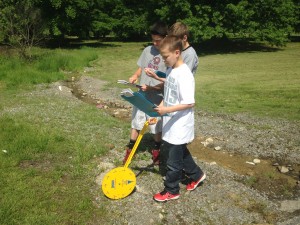Wetland Warriors

Originally appears in the Fall 2014 issue
When was the last time you drove past an area and saw new construction? Did you wonder if the construction was disturbing a natural wetland? Since the 1950s we are facing an estimated 50% loss of the wetlands worldwide so why not introduce this problem to our students as they learn about the importance of wetlands and investigate local biodiversity?[i]
Teachers can make a difference in our communities and environment by what we teach and how we do it. All teachers have set standards to follow, but there are always real-world applications that can make the learning more meaningful for students. Sometimes those learning opportunities may be outside of your classroom window, away from the desks, textbooks and chalkboards.
Sometimes those learning opportunities can be cross-curricular. Most students would groan if you told them they had to do math or language arts in science class. But what might happen if you integrate math, language arts and science while teaching the students about an important environmental issue with real-world implications? Developing environmental stewardship, combining “academics with community action,” can also apply mathematics to the development of understanding of both local biodiversity and concrete environmental issues.[ii] Reading about wetlands from a textbook is not as profound as researching and working to create a wetland while learning both inside and outside of the classroom.
The middle school lesson described below utilizes key components of a problem-based learning approach by exhibiting the problem as a real-world situation, having students work in groups to explore information inside and outside of the classroom, guiding critical thinking skills and applying student knowledge in the context in which it is used.[iii]
To view the photo-rich magazine version, click here.
If you are not already a subscriber, please subscribe to read the full article
Eric Diefenderfer teaches 7th grade science at Boardman Glenwood Middle School in Boardman, Ohio. Eric is currently enrolled in the Advanced Inquiry Program through Project Dragonfly, Miami University.
[i] Kettlewell, C. (2005). An Inventory of Ohio Wetland Compensatory Mitigation Part 2. Final Report to U.S. EPA Grant No. CD97576201-0. Retrieved from http://www.epa.ohio.gov/portals/35/wetlands/WetlandMitigationInventory_Mar2005.pdf
[ii] Ball, A. (2013) Swamped: Louisiana students become wetlands custodians. Edutopia. Retrieved from http://www.edutopia.org/wetland-watchers-service-learning
[iii] Boud, D. & Feletti, G. (1998). The Challenges of Problem-Based Learning. London: Kogan Page Limited.
Leave a Reply
You must be logged in to post a comment.











very interesting info ! .